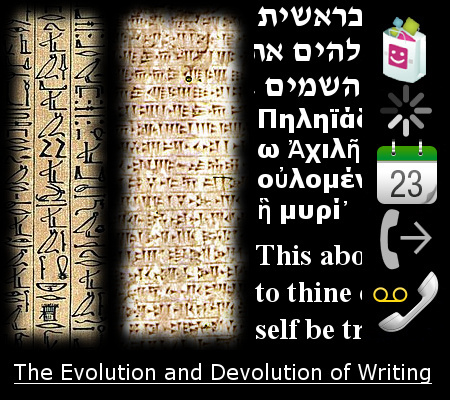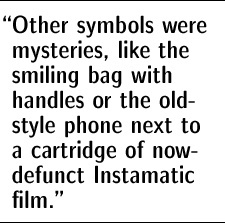
For 5,000 years humankind has been steadily marching forward with ever-better written communication. But I fear that we are outmatched by the iPhone, the PC, and similar technology, which like Frankenstein's monster have turned against us, secretly conspiring to thrust us back to the near illiteracy of the Stone Age.
The problem is that we're abandoning our reliable alphabet in favor of quirky icons.
Similar to pictures, icons convey meaning, but unlike pictures, they don't have to resemble what they represent. And they're not new. We've long used a triangle on top of a square to mean “house” (even though there are no houses that look like that) and a leaf-like shape to mean both “heart” and “love” (even though real hearts have four chambers and the shape has only two).
But with the advent of graphical digital technology, icons have begun marching slipshod over real words.
I realized the magnitude of the impending disaster when I needed technical support for a new Blackberry. (Yes, I have a Blackberry. Get over it.)
“Go to 'options,'” a tech support rep. told me on the phone.
I was stumped, because the screen on my new device showed nothing more than a cute collection of colorful shapes and squiggles.
I recognized some of them: The “23” designed to look like part of a flip pad was the calendar (because it happened to be the 23rd day of the month) and the envelope was my e-mail (even though e-mail doesn't come in envelopes).
Other symbols were mysteries, like the smiling bag with handles or the old-style phone next to a cartridge of now-defunct Instamatic film. (The bag was the cell provider's e-store, presumably because nothing makes a person happier than shopping. The now-defunct Instamatic film cartridge was in fact a now-defunct audio recording tape, and in conjunction with the phone it represented my voice mail.)
The Blackberry is not alone in confusing the user in this way. The iPhone has both a spinning sun and a motionless quarter moon. It turns out that the sun (because it's moving?) represents network activity. And the moon -- which Apple says you want to activate for “dinner” among other things -- indicates “do not disturb” mode, because (well, now it's obvious) the moon only comes out at night (except not really) and nighttime is when you don't want to be disturbed.
Had I taken auto shop in high school, I might have been able to find the original “options” icon that I was looking for. I have a vague recollection that cars used to have carburetors and that these and other important car things could be adjusted by turning nuts with a wrench. Options on a phone, apparently, are like adjustments to a car. I should have been looking for something that resembled a nut and a wrench.
Perhaps it is this proliferation of icon-based communication that has made the Japanese emoji (“picture characters”) so popular. According to Businesss Insider, everyone was “very excited” about new emoji, while Mashable wonders why everyone is “obsessed” with them. I have my doubts.
Iconic writing is not without value, of course. In Hungary some years ago, I excused myself from a restaurant dinner with colleagues to look for the restrooms. I was dismayed to find two doors, each with what could have been a random letter. Icons for “male” and “female” would certainly have been nice.
And the Egyptians used iconic writing in the form of hieroglyphics to create a great society. But their inventory of symbols was so vast that only skilled scribes could master the system. Without the scribes, Egypt could never have thrived, which is why a 4,000-year-old Egyptian text proclaims that there is no greater calling than to be a scribe. (On the other hand, it was a scribe who wrote that.)
About 5,000 years ago, the Sumerians realized that they could write down a word's sounds instead of its meaning. Their system focused on syllables and eventually gave the world the famous Cuneiform, which whittled down the inventory of writing symbols from thousands to mere hundreds. But still, only scribes could read and write.
In the 2nd millennium BC, the Phoenicians created a writing system that required fewer than 30 symbols, because it had only consonants. But again, it remained beyond the reach of the layperson.
Then around the time of King David, the Israelites in Jerusalem doubled up a few of those Phoenician consonants, using them for vowels. Now a collection of about two dozen symbols could be used to write anything down, and anyone could master the system. Widespread literacy was born. (This is why everyone knows about the Bible. By contrast, even though most people have heard of the Phoenicians, few have read any books by them.)
This alphabetic system of consonants and vowels was so successful that it was copied by the Greeks and then the Romans, eventually to become the major writing systems of the Americas, Europe, India, and the Middle East. (And in spite of popular conception, the writing systems of the Far East record pronunciation in addition to meaning, as, in fact, did hieroglyphics.)
So the alphabet is the primary technology that makes it possible to send text messages, compose e-mail, write computer code, publish newspapers, jot down shopping lists, and, in general, communicate across time and space. Progress for the last 3,000 years has been intricately tied up with the alphabet and its almost magical way of letting people communicate.
The alphabet will survive, in spite of the onslaught by modern graphical interfaces. And our phones and computers will continue to work. But I can't help wonder how much more efficient the whole endeavor would be if we didn't base it on technology so antiquated that even King Tut would have thought it was primitive.
The author uses the alphabet to write fiction and non-fiction. His latest work, The Bible's Cutting Room Floor, hits book stores on September 2, 2014, with a sneak peek available now to those who pre-order.


